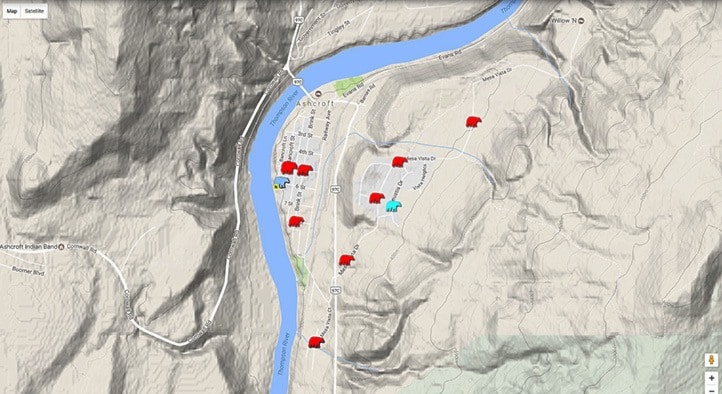Spring has only just started, meaning most people probably won’t be thinking about bear season yet. But Frank Ritcey, the provincial coordinator for WildSafe BC, says it’s not too early to start preparing for bears, especially in the Ashcroft area.
“Generally, you know it is time to start getting ready for bears by the first week of May, when they’re out of their dens,” he says. “Watch for the leaves on cottonwood trees: when they’re the size of a loonie, the bears are out.
“Ashcroft always seems to get early bears. They hibernate fairly consistently, but there are always outliers where bears come out early. It depends on the shape they were in when they started hibernating. If they didn’t have good stores of fat they’ll come out early, or if there’s run-off that floods their dens.”
He points to data showing that bears are routinely seen in and around Ashcroft in April. In 2014 there were several reports of bears in town by the end of March; and Ritcey says that most of the calls indicate the bears are out after garbage.
“You don’t think of Ashcroft as bear country, because it’s so dry,” he says. “But if the bears come out early looking for food, the first place they find it is in the valley bottom. And in more than 50 per cent of the calls we get where an attractant is named, it’s garbage.”
Ritcey advises people to manage their garbage by not putting it out until close to the time of pick-up. Other tips for keeping bears away from your yard include taking bird feeders down, and not putting food outside for household pets.
“Get your bird feeders down before the bears come out. One kilogram of birdseed has between 7,000 and 8,000 calories, whereas one kilogram of huckleberries has about 500 calories. You know which one bears will go for.”
All kinds of things come for pet food, he adds. “It’s a bad one. Not only will you get bears, you’ll get rodents, which the bears will also come after.”
Well-managed compost should not attract bears, but Ritcey says that over the winter people who compost are mostly throwing in food scraps, not dried leaves and grass. “Mix enough browns with your greens, to make sure you’re not putting out bear food.”
Deer can also be a nuisance for property owners, wreaking havoc in gardens, bringing ticks, and often posing a danger to people and household pets when they feel threatened.
“’Deer resistant’ claims on plants and flowers can be wishful thinking,” says Ritcey. “If there are better-tasting plants then the deer will eat them first, but when those are gone they’ll eat almost anything. The plants are deer resistant, not deer proof.
“Tick season is coming up. Lots of people like having deer in their yard, think it’s nice to see them, but they are a vector [carrier] for ticks. And deer can become quite aggressive in a couple of months, when they’re giving birth. We get a lot of calls about aggressive deer, which can attack and kill dogs.
“The deer are just being defensive, as a response to us being here, but we perceive it as aggression. Deer are a big issue in B.C. If a cougar shows up, everyone knows it’s a problem. If one deer shows up, everyone says ‘That’s so cute,’ but then 12 show up in your garden and it’s a problem. You have to know when it’s crossed that line.”
There are few options for keeping deer out of your yard, he notes. “The tough part is that if you don’t like deer and your neighbour does, you’ll have deer in your yard.” The best way of keeping them out is a wood panel fence. “It doesn’t need to be super high if it’s made of wood,” says Ritcey. “If the deer can’t see what’s on the other side they’ll hesitate. If they can’t see what they’re jumping into, they won’t do it.
“People like to see the deer and feed them, and don’t see the long-term consequences of feeding wildlife.”
